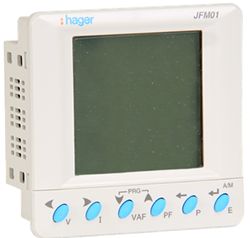With energy monitoring becoming a requested feature for commercial
buildings, allowing building owners or managers to obtain actionable
information about their energy usage, will this mean that installers have
to deal with more sophisticated building management systems – or is
there a simpler solution? Steve Dyson of Hager explains how plug-in
meters can provide the answer.
buildings, allowing building owners or managers to obtain actionable
information about their energy usage, will this mean that installers have
to deal with more sophisticated building management systems – or is
there a simpler solution? Steve Dyson of Hager explains how plug-in
meters can provide the answer.
Economic news has recently been focused on the falling price of energy, but
the fact that the financial cost of electricity may fall doesn’t remove Government
emphasis on the bigger issues of the cost to the planet. Regardless of the cost
of energy, building owners are increasingly responsible for monitoring and
reducing their consumption in order to contribute to the national and global efforts
to reduce CO² emissions.
One area in most buildings where there is potential for savings, in both usage and
cost, is in general and display lighting which, it is estimated, can be responsible for
between 20 and 40 per cent of energy consumed, so a minimum requirement is
the ability to monitor the energy consumption of a building’s lighting. A solution that
offers a simple but effective technology, that is compatible with the experience
of any qualified electrical installer, is a plug-in energy-monitoring meter that connects
to the pulsed output of various kWh meters in the building.
From the installer’s point of view, plug-in meters, like those manufactured by Hager, offer a range of benefits, not least labour savings of around 90 per cent compared with traditional wiring methods. Plug-in meters can be DIN-rail mounted for split loads, enabling the connection of two three-phase current transformers into one meter, typical applications including split load distribution boards. ‘Plugability’ is simple and involves simply plugging one lead into the multi-function power meter and the other into the three-phase current transformer. If more than one meter is involved, it is simply a case of plugging the ready-made linking lead connector from the first to the second meter. Up to 32 energy meters can be powered from a single power source. Where panel mounting is required, the secondary meter is powered up by connecting it to the supply and it is then plugged into the multi-function power meter and connected to the three-phase current transformer.
the fact that the financial cost of electricity may fall doesn’t remove Government
emphasis on the bigger issues of the cost to the planet. Regardless of the cost
of energy, building owners are increasingly responsible for monitoring and
reducing their consumption in order to contribute to the national and global efforts
to reduce CO² emissions.
One area in most buildings where there is potential for savings, in both usage and
cost, is in general and display lighting which, it is estimated, can be responsible for
between 20 and 40 per cent of energy consumed, so a minimum requirement is
the ability to monitor the energy consumption of a building’s lighting. A solution that
offers a simple but effective technology, that is compatible with the experience
of any qualified electrical installer, is a plug-in energy-monitoring meter that connects
to the pulsed output of various kWh meters in the building.
From the installer’s point of view, plug-in meters, like those manufactured by Hager, offer a range of benefits, not least labour savings of around 90 per cent compared with traditional wiring methods. Plug-in meters can be DIN-rail mounted for split loads, enabling the connection of two three-phase current transformers into one meter, typical applications including split load distribution boards. ‘Plugability’ is simple and involves simply plugging one lead into the multi-function power meter and the other into the three-phase current transformer. If more than one meter is involved, it is simply a case of plugging the ready-made linking lead connector from the first to the second meter. Up to 32 energy meters can be powered from a single power source. Where panel mounting is required, the secondary meter is powered up by connecting it to the supply and it is then plugged into the multi-function power meter and connected to the three-phase current transformer.
 Plug-in meters are safer than using traditional current transformers because they incorporate the resistive shunts usually located within the power meter. This means that the secondaries are always loaded, eliminating the possibility of dangerously high voltages developing during open circuit conditions. Other fitted components also provide redundancy in the event that the resistor should fail. This allows the meter-to-current-transformer lead to be disconnected without the need for secondary shorting terminals, again saving money and reducing downtime. The design of both the current transformers and the meters allow plug-in connectors to be used for both current and voltage input/output.
Plug-in meters are safer than using traditional current transformers because they incorporate the resistive shunts usually located within the power meter. This means that the secondaries are always loaded, eliminating the possibility of dangerously high voltages developing during open circuit conditions. Other fitted components also provide redundancy in the event that the resistor should fail. This allows the meter-to-current-transformer lead to be disconnected without the need for secondary shorting terminals, again saving money and reducing downtime. The design of both the current transformers and the meters allow plug-in connectors to be used for both current and voltage input/output.The demands for energy monitoring can only increase as we see the energy-saving bar being raised ever higher. From the user’s point of view, monitoring energy consumption with the use of sub-meters helps understand where money can be saved and at the same time helps to reduce carbon emissions.




